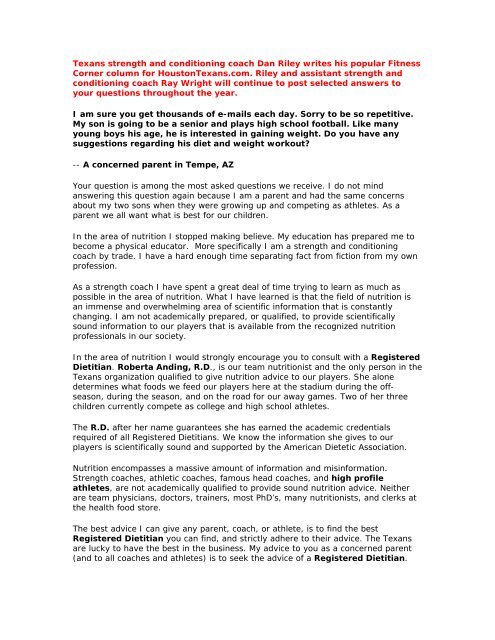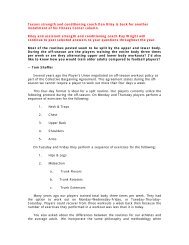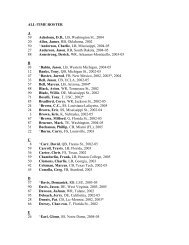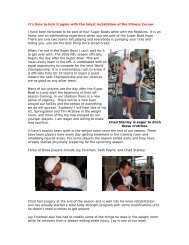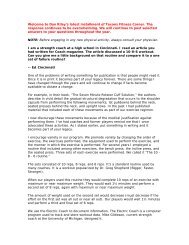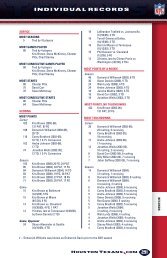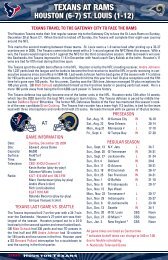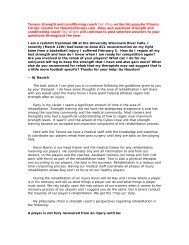Texans strength and conditioning coach Dan Riley writes his ...
Texans strength and conditioning coach Dan Riley writes his ...
Texans strength and conditioning coach Dan Riley writes his ...
Create successful ePaper yourself
Turn your PDF publications into a flip-book with our unique Google optimized e-Paper software.
B. Upper BackC. Shoulders5. ArmsA. BicepsB. TricepsC. ForearmsEventually, each of these muscle groups must be targeted to generate maximumgains in muscular development. It is important to emphasize total bodydevelopment. Many <strong>strength</strong> programs focus on a few basic lifts. Athletes becomewell-skilled at a few basic exercises but ignore total body development.I have mentioned many times how important it is for athletes to focus on total bodydevelopment <strong>and</strong> not becoming a good weight (thrower) lifter. The muscles of theneck <strong>and</strong> traps must be the number one priority for any athlete exposed to collisionsinvolving the head, neck.Another question about repetitions. Why a higher range for lower bodyexercise than upper body (ie. 12 vs. 10 or 8)? Is the rep range the key tomaximum <strong>strength</strong> gains?Coach Aaron Hillmann, Strength Coach, Bowling Green, OhioI am far more concerned with “How each rep is performed?” than with, “How manyreps are performed?” In my thirty-three years as a <strong>strength</strong> <strong>coach</strong> I haveexperimented with most set/rep combinations. I have had athletes perform multiplesets of one repetition, <strong>and</strong> as many as fifty repetitions.It has taken me far too long to realize that all set/rep combinations are productive, ifadequate overload is provided each workout. Getting stronger is possible if anathlete attempts to lift more weight <strong>and</strong>/or performs more reps each exercise ofevery workout.Wow! How deep. Hmmmm! Lift more weight <strong>and</strong>/or more reps <strong>and</strong> you get stronger.How novel. Someone tell the <strong>strength</strong> training community that we are stealing. Willsomeone please tell the world that getting stronger is not a science?The Overload Principle is the most basic tenet of any <strong>strength</strong> improvement program.To increase <strong>strength</strong> you must force the muscles to adapt to an ever increasingstress. The additional stress will force the muscles to adapt causing an increase in<strong>strength</strong>.You ask about our rep range for our players’ lower body exercises (twelve reps)versus our rep range for the upper body (eight to twelve reps). There really is notthat much of a difference.
I am unaware of any research that supports the need to significantly increase thenumber of repetitions for lower body exercise. My first exposure to a potentialdifference in upper <strong>and</strong> lower body rep ranges occurred during one of my many visitsto the Nautilus facility in Florida to meet with Arthur Jones.During my visit Mr. Jones used Casey Viator, at the time a high profile <strong>and</strong>genetically gifted bodybuilder as a volunteer. Casey was asked to perform a staticcontraction of two exercises on an exercise tensiometer in an all out manner. Thetensiometer allowed us to observe how many pounds of pressure he exerted whileperforming the leg extension <strong>and</strong> the bench press.The leg extension is an isolation lower body exercise for the quadriceps, <strong>and</strong> thebench press is a multi-joint exercise incorporating the smaller muscles of the chest,shoulders, <strong>and</strong> triceps.Casey was initially connected to the tensiometer in a position to test <strong>and</strong> isolate <strong>his</strong>quadriceps. He was instructed (<strong>and</strong> verbally motivated) to exert a maximum effortagainst the tensiometer. His quads were being tested at a fixed point. He wasinstructed to push as hard as he could until the amount of tension exerted droppedto fifty percent of <strong>his</strong> initial maximum.We then positioned the tensiometer so we could test him in the same manner usingthe bench press. He was instructed to push as hard as possible until the initialtension exerted dropped to fifty percent of <strong>his</strong> initial maximum.His lower body (leg extension) took more time to reduce <strong>his</strong> <strong>strength</strong> level to fiftypercent of <strong>his</strong> initial maximum effort than did <strong>his</strong> upper body (bench press). If Iremember correctly <strong>his</strong> quads took sixty-eight seconds to reduce <strong>his</strong> initial <strong>strength</strong>level to fifty percent of its’ initial maximum.The bench press took just over forty-seconds to reduce <strong>his</strong> initial <strong>strength</strong> level tofifty percent of its’ maximum.It is due to t<strong>his</strong> specific event that I have always believed the larger muscles of thelower body need more time (reps) to activate every available muscle fiber. Aftermany years of experimenting <strong>and</strong> listening to player feed back, I now believe we cangenerate the best results, <strong>and</strong> insure adequate recovery by adhering to twelve repsfor the muscles of the hips <strong>and</strong> legs.I continue to learn <strong>and</strong> look for safer <strong>and</strong> more effective methods to train ourplayers. Any <strong>and</strong> all suggestions are welcome.


